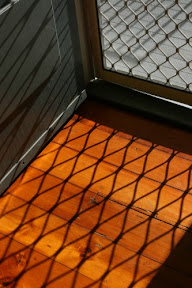Brisbane Organic
Growers Inc Annual Fair, Sunday 2nd
October, 2011
I have chosen to photograph a local
fair run by the
Brisbane Organic Growers Inc (BOGI). I chose the
organising committee as my notional client and my brief was to
photograph the fair in all it's parts. This would include setup
before the actual fair, the stalls, cafe, vegetable growing
competition and auction at the end of the day. This was to be
prepared in a short photo essay which would be included in the
November newsletter and thus had a deadline of two weeks after the
fair.
Having not attended a BOGI fair
before, I did some research as to what might happen on the day. I
made a list of possible targets for photographing.
Preparation (both the day
before and also the morning of the fair)
Cafe ( serving freshly prepared
food and home made cakes)
Vegetable growing competition
and judging (display?)
Stalls (selling produce, giving
advice, demonstrations etc)
Auction of competition items
Tidying up at the end of a long
day.
Photo 1. Preparation. Setup
area for stalls
17-35mm f/2.8 lens, Canon
30D, f/6.7, 17mm, 1/90sec, ISO 640, natural light.
Photo 2. Preparation. Menu
50mm f/1.8 lens, Canon 30D,
f/4.5, 50mm, 1/90sec, ISO 640, bounce flash.
Photo 3. Preparation. Red check
tablecloth
17-35mm f/2.8 lens, Canon
30D, f/4.5, 17mm, 1/45sec, ISO 640, bounce flash.
Photo 4. Cafe. Preparing
cupcakes in the kitchen
17-35mm f/2.8 lens, Canon
30D, f/2.8, 19mm, 1/60sec, ISO 1000, diffuser on flash.
Photo 5. Cafe. The first
punters arrive
17-35mm f/2.8 lens, Canon
30D, f/4.5, 17mm, 1/45sec, ISO 1000, diffuser on flash.
Photo 6. Cafe. Choosing and
Paying
17-35mm f/2.8 lens, Canon
30D, f/6.7, 17mm, 1/45sec, ISO 1000, diffuser on flash.
Photo 7. Stalls. Forbidden
Fruits Nursery
17-35mm f/2.8 lens, Canon
30D, f/11, 17mm, 1/180sec, ISO 640, natural light.
Photo 8. Stalls. Tropical
Fruits trio
17-35mm f/2.8 lens, Canon
30D, f/5.6, 17mm, 1/90sec, ISO 640, diffuser on flash.
Photo 9. Stalls. Tea for sale
50mm f/1.8 lens, Canon 30D,
f/5.6, 50mm, 1/250sec, ISO 500, natural light.
Photo 10. Competition. Viewing
the entries
50mm f/1.8 lens, Canon
30D, f/2.8, 50mm, 1/90sec, ISO 500, natural light.
Photo 11. Competition. A young
prizewinner
50mm f/1.8 lens, Canon
30D, f/5.6, 50mm, 1/60sec, ISO 640, diffuser on flash.
Photo 12. Auction. Graeme and
Charlie call the auction
50mm f/1.8 lens, Canon
30D, f/3.5, 50mm, 1/60sec, ISO 640, diffuser on flash.
Photo 13. Auction. Bidding
50mm f/1.8 lens, Canon
30D, f/5.6, 70mm, 1/60sec, ISO 640, diffuser on flash.
Photo 14. Auction. A young
bidder
70-200mm f/2.8 lens, Canon
30D, f/6.7, 120mm, 1/60sec, ISO 640, diffuser on flash.
Photo 15. End of the day
70-200mm f/2.8 lens, Canon
30D, f/6.7, 125mm, 1/60sec, ISO 640, natural light.
From Penny, BOGI vice
president:
'Your
photo story depicts from setup to cleanup and so much of the colour
in-between, really wonderful.' It's a pleasure being able to provide
a great set of photos to a client.




















































